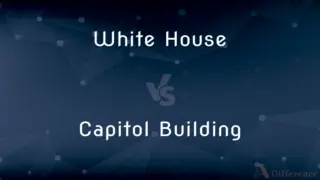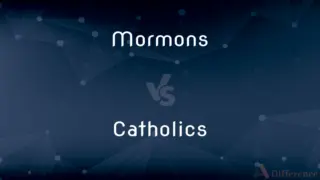Cross Stitch vs. Embroidery — What's the Difference?
By Maham Liaqat & Fiza Rafique — Published on February 28, 2024
Cross Stitch is a form of embroidery that uses X-shaped stitches to form a picture, ideal for beginners due to its simplicity, whereas Embroidery encompasses a broader range of techniques and stitches for decorative fabric art.

Difference Between Cross Stitch and Embroidery
Table of Contents
ADVERTISEMENT
Key Differences
Cross Stitch is a popular form of counted-thread embroidery, characterized by its use of X-shaped stitches in a tiled pattern to create intricate designs and pictures. It's often done on evenly woven fabric like Aida or linen, which makes it easier to count and place stitches accurately. The simplicity and precision of cross stitch make it an accessible craft for beginners, with patterns ranging from simple designs to complex pieces of art.
Embroidery, in a broader sense, is the art of decorating fabric using a needle and thread or yarn. Unlike cross stitch, embroidery encompasses a variety of stitches and techniques, such as backstitch, satin stitch, and French knots, allowing for more diverse and free-form designs. Embroidery can be applied to various types of fabric and is not limited to the grid-like structure of cross stitch, offering more flexibility in terms of design and creativity.
Cross stitch is more structured and formulaic, while traditional embroidery offers more freedom, allowing the artist to blend stitches, colors, and textures in unique ways. Embroidery can be used to embellish garments, household items, and decorative art pieces, making it a versatile craft suitable for a wide range of applications.
The choice between cross stitch and embroidery depends on the desired outcome and the crafter's skill level. Cross stitch is ideal for those who appreciate the ease of following a pattern and the satisfaction of seeing a pixel-like image emerge, while embroidery is better suited for those looking to explore a wider variety of stitches and more fluid, artistic expressions.
Both crafts share the basic tools of needlework, such as needles, thread, and fabric, but their techniques, execution, and final appearance can be quite different. Whether one chooses cross stitch for its methodical approach or embroidery for its artistic freedom, both crafts offer a fulfilling way to create beautiful, handcrafted textile art.
ADVERTISEMENT
Comparison Chart
Stitches
Primarily X-shaped stitches.
Wide variety, including satin, backstitch, and French knots.
Fabric
Evenly woven, like Aida or linen.
Any type, with varying weaves and counts.
Technique
Counted-thread based on a grid pattern.
Free form, with more artistic flexibility.
Skill Level
Beginner-friendly, more structured.
Ranges from beginner to advanced, more varied techniques.
Applications
Decorative art, themed designs.
Garment embellishment, decorative items, art pieces.
Compare with Definitions
Cross Stitch
Ideal for beginners.
Beginners often start with cross stitch to learn the basics of needlework.
Embroidery
Decorative fabric art.
The embroidery on the dress featured exquisite floral motifs.
Cross Stitch
Counted-thread embroidery.
She completed a cross stitch sampler as her first needlework project.
Embroidery
Used on various fabrics.
The delicate silk scarf was enhanced with vibrant embroidery.
Cross Stitch
Uses X-shaped stitches.
The cross stitch pattern transformed into a detailed floral design.
Embroidery
Variety of stitches and techniques.
She used satin stitch and French knots in her embroidery project.
Cross Stitch
Produces pixel-like images.
The intricate cross stitch piece resembled a pixelated landscape.
Embroidery
Offers artistic freedom.
Freehand embroidery allowed her to express her creativity without constraints.
Cross Stitch
Follows a grid pattern.
The cross stitch design was carefully mapped out on a grid.
Embroidery
Embellishes garments and items.
The hand-embroidered tablecloth became a family heirloom.
Cross Stitch
To make or embroider with X-shaped stitches.
Embroidery
A piece of embroidered fabric.
Cross Stitch
A double stitch forming an X in sewing and embroidery.
Embroidery
The act or art of embroidering.
Cross Stitch
Embroidery done in cross-stitch.
Embroidery
Embellishment with fanciful details.
Common Curiosities
Do cross stitch and embroidery use the same materials?
Both crafts use similar basic materials like needles, thread, and fabric, but the specific types of each may vary based on the project, such as the use of tightly woven Aida cloth for cross stitch.
What is the main difference between cross stitch and embroidery?
Cross stitch is a specific type of embroidery that uses X-shaped stitches and follows a grid pattern, while embroidery is a broader category that includes various stitches and techniques.
Is cross stitch faster than embroidery?
Cross stitch can be both fast and slow, depending on the complexity of the design. It's generally considered methodical and straightforward, which might make it faster for some, but embroidery can also be quick if simple stitches are used.
How do I choose between cross stitch and embroidery for my project?
Consider the desired outcome, your skill level, and the type of design you wish to create. Cross stitch might be preferable for structured, pixelated designs, while embroidery offers more flexibility for varied and intricate motifs.
Can cross stitch patterns be used for embroidery?
Cross stitch patterns can be adapted for embroidery, but the translation might require creative adjustments to accommodate different stitches and techniques used in embroidery.
Can beginners do embroidery, or is it just for advanced crafters?
Beginners can certainly start with embroidery, as there are many simple stitches and techniques suitable for novices, allowing them to gradually progress to more complex designs.
Can embroidery be done on any fabric?
Embroidery can be done on a wide range of fabrics, but the choice of fabric can affect the ease of stitching and the final appearance of the embroidery, so it's important to select fabric suited to the specific embroidery technique.
Is a hoop necessary for both cross stitch and embroidery?
While not absolutely necessary, a hoop can help maintain fabric tension in both cross stitch and embroidery, leading to neater stitches and easier stitching, especially for beginners.
Are there any digital tools to help with cross stitch or embroidery designs?
Yes, there are several digital tools and apps available that can help with designing patterns, converting images into cross stitch or embroidery patterns, and even simulating the finished look.
How can I improve my skills in cross stitch or embroidery?
Practice regularly, experiment with different stitches and techniques, follow tutorials, join workshops or classes, and engage with the crafting community for tips and inspiration.
Share Your Discovery

Previous Comparison
White House vs. Capitol Building
Next Comparison
Mormons vs. CatholicsAuthor Spotlight
Written by
Maham LiaqatCo-written by
Fiza RafiqueFiza Rafique is a skilled content writer at AskDifference.com, where she meticulously refines and enhances written pieces. Drawing from her vast editorial expertise, Fiza ensures clarity, accuracy, and precision in every article. Passionate about language, she continually seeks to elevate the quality of content for readers worldwide.














































